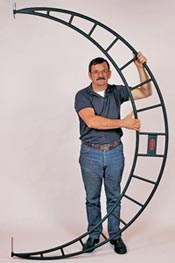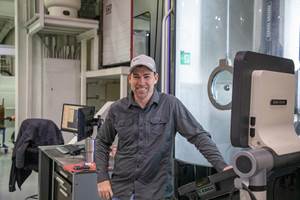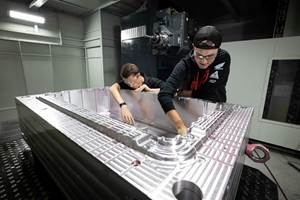Metalworking Skills Are in Demand Among Green Power Suppliers
Mold shops seeking new business have sizeable opportunities machining parts for new energy systems.
With the global economy in recession and mold shops facing tough challenges in finding or keeping customers, a major opportunity is developing for business in a high-growth area: alternative energy.
The market is creating jobs for companies with metal-fabrication skills that read like a prospectus of mold shop assets. These include the ability to precision machine metal castings, maintain advanced quality control programs, deliver increasing amounts of parts on time and maintain cost-competitiveness in a global market.
If these requirements sound like standard operating procedure at most mold shops, they are. Moldmakers who for years turned out high-precision, cost-competitive tools for automotive, electronics and other advanced markets are finding that their machining and fabrication expertise is in demand by producers of alternative energy equipment.
And unlike the auto industry, growth prospects in alternative energy appear strong and sustainable. It is also unlikely that component work will go offshore.
Growth Prospects
“If anybody is surviving nowadays, it’s because they’re diversifying,” says Greg Langenhorst, Technical Marketing Manager at MC Machinery Systems (Wood Dale, IL). “Moldmakers who were doing 90 to 95 percent of their business in automotive can’t survive doing that anymore.”
A few moldmakers have started working in alternative energy, machining relatively small castings for such applications as wind turbines, solar-generating systems, biomass incinerators and nuclear power plants.
Some of the work is confidential, especially in solar systems and nuclear energy—solar systems because proprietary technology goes into component design to optimize refraction values, and nuclear power, it seems, for competitive reasons among mold shops. (One toolmaker, when queried about his work in this area, replied, “How do you know we’re in this industry, if, in fact, we are?”)
Most of the industry, however, is open about its work. OEMs and contractors are looking for sources that can fill the supply chain that is necessary to design, build and maintain systems.
At the same time, producers and distributors of machining centers and related equipment are promoting the benefits of their products to moldmakers for the market. They’re also offering support in the form of seminars about doing business in the field and technical assistance to get the most performance out of new or existing machining systems.
Mark Rentschler, Marketing Manager at Makino (Mason, OH), says his company, for one, “has been in dialog with mold manufacturers seeking to diversify their businesses and helping them understand how technologies can be used, or what different technologies might be necessary, to successfully compete in the market.”
Alternative energy suppliers are steadily building an infrastructure across North America to generate electricity without fossil fuels. Much attention is focused on the potential for sustainable and clean power from wind turbines and solar panels. But the market also includes technologies that are designed to reduce demand for electricity in buildings and other structures.
The effort is heavily backed by the federal government, which sees alternative energy as an important way to meet environmental needs and wean the country from imported oil and its occasional uncertainty in pricing and supply. The Obama administration, for example, wants 10 percent of electricity to come from renewable sources in 2012 and 25 percent by 2025.
Wind Energy
Major investments are being made in the effort. The American Wind Energy Association (Washington, DC) reports that in 2008, the U.S. wind energy industry installed more than 8,300 megawatts of capacity—a growth rate of 31 percent over the previous year and an investment of more than $7.8 billion in equipment. Association members installed 4,500 wind turbines last year, and the industry as a whole employed 85,000, 66 percent more than in 2007. Forecasts call for a decline this year owing to the recession, but 2009 is still projected to see at least 5,000 megawatts of capacity commissioned.
A wind turbine is a huge device. The 36 turbines in use by the Nebraska Public Power District, for example, are each 230 feet high and have three 130-foot-long composite blades; rotor diameter is 269 feet. Each turbine needs about a half acre of land. The facility has a capacity of 60 megawatts, enough to power 19,000 households.
A turbine has about 8,000 components, half of which are manufactured in the U.S. Metal components are approximately 90 percent of the weight of a turbine, and while some are too large and heavy for moldmakers to machine, many parts, such as those used in generator and gearbox assemblies, bearings, electronic systems or as fasteners, can be machined on conventional toolmaking systems. In Europe, which has a long history of wind turbine use, moldmakers have been machining these components for years.
Technology Offerings
Suppliers say that 5-axis machining systems are the best equipment for wind turbine parts. This is because of the greater degree of cutting freedom with the two extra axes of motion, which is a plus for beveled parts like gears. Following are representative examples of what’s being offered.
Mazak Corp. (Florence, KY) touts its Versatech V-140 machining center for wind turbine work. Marketing Manager George Yamane says a key feature of the double-column, 5-axis system is the size of its worktable: 433 X 181 X 76 inches, which supports 95,000 lb. The V-140 has a nutating head, as well as B- and C-axis rotary motions that deliver 50-hp cuts at almost any angle, a capability that reportedly increases productivity as much as 50 percent.
Distributor Methods Machine Tools (Sudbury, MA) offers a number of milling machines that it claims are suitable. One is the MAM72-63V from Matsuura, a 5-axis design. Scott McIver, Chairman and Vice President of Product Development, says the basic unit handles 28.3 X 17.7-inch workpieces weighing 880 lb (1,320 lb under some conditions). Standard spindle speed is 12,000 rpm, though a 30,000-rpm spindle is an option. McIver says 500 tools can be stored on the machine.
Langenhorst of MC Machinery Systems says one of the companies it represents, Roku-Roku, developed a 5-axis gantry model called RMX-50V that is designed to maximize the accuracy and productivity of high-speed and hard milling operations. The unit has a 23.6 X 19.6 X 15.7-inch rate of travel, 30,000- or 40,000-rpm. spindle and stores 60 tools.
Companies supplying taps and end mills usually have a range of products for wind turbine machining, since they provide such equipment to similar industries. Emuge Corp. (West Boylston, MA), for example, has taps and thread mills that provide long reach for threading large components, a representative says.
L.S. Starrett Co. (Athol, MA), which produces instruments for measurement, has products that simplify work with large parts. DataSure is a wireless system that transmits time-stamped measurements and other data across a factory, from an end node (attached to the measuring device) via routers to a gateway that connects to a computer. The 916-MHz system can be used with a micrometer, caliper or other indicators. The benefits are accuracy, working on components anywhere in a shop and elimination of cords and wires.
The company also makes the No. 724 Big Mic, an oversized micrometer (72- to 78-inch range) with interchangeable anvils.
Growth on the Horizon
Alternative energy is a fast-growing market with a lot of support. Installations account for a minuscule amount of energy (wind power is 1.5 percent of U.S. electricity generation), so major growth is on the horizon. Moldmakers can readily apply their fabrication expertise to machining components for wind, solar and other applications, and thereby find plenty of ways to grow their businesses.
Related Content
How to Eliminate Chatter
Here are techniques commonly used to combat chatter and guidelines to establish a foundation for optimizing the moldmaking process.
Read MoreThree Good Reasons to Switch from Three- to Five-Axis Machining in Moldmaking
Five-axis machining technology is a great tool in the moldmaker toolbox.
Read MoreSpeed, Productivity Gains and High Uptime Ease Decision for Second Five-Axis Machine
Byrne Tool + Design reduced setups and gained speed and productivity thanks to fast, accurate and compact five-axis CNC machining centers.
Read MoreHybrid Milling/Drilling Machine Reduces Total Mold Machining Time
MSI Mold Builders now squares, plus drills and taps eye-bolt holes on 50% of its tools in a single setup using a five-axis milling/drilling center with a universal spindle.
Read MoreRead Next
How to Use Continuing Education to Remain Competitive in Moldmaking
Continued training helps moldmakers make tooling decisions and properly use the latest cutting tool to efficiently machine high-quality molds.
Read MoreHow to Use Strategic Planning Tools, Data to Manage the Human Side of Business
Q&A with Marion Wells, MMT EAB member and founder of Human Asset Management.
Read MoreReasons to Use Fiber Lasers for Mold Cleaning
Fiber lasers offer a simplicity, speed, control and portability, minimizing mold cleaning risks.
Read More























